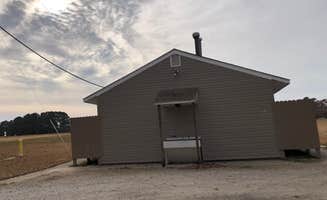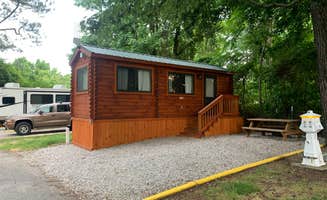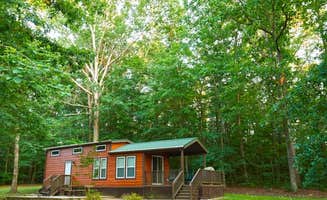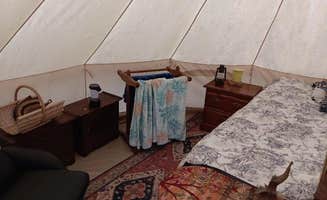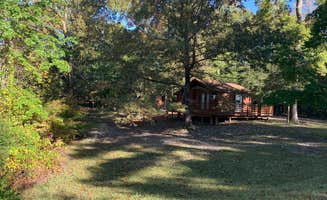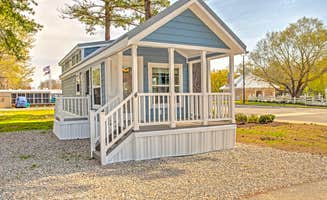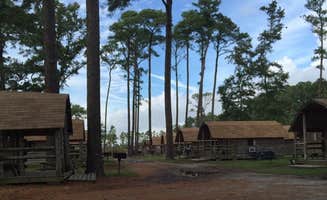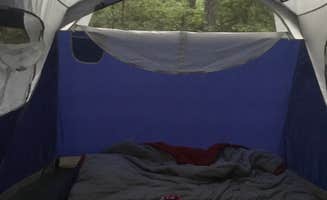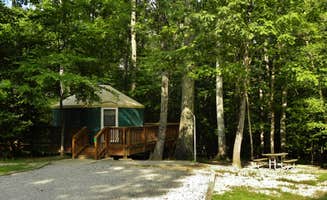Camping opportunities near Jamestown, Virginia center around the Chickahominy and James Rivers where summer temperatures regularly exceed 90°F with high humidity from June through August. Most campgrounds in the region sit at elevations under 100 feet above sea level, creating flat, accessible sites within short driving distance to Colonial Williamsburg, Jamestown Settlement, and other historical attractions.
What to do
Bike the Virginia Capital Trail: The paved path runs near Chickahominy Riverfront Park, offering miles of scenic riding. "Ideal place for a family if you are fully contained... Also a great paved biking path that goes for a number of miles," notes one reviewer.
Paddle the Chickahominy River: Multiple access points allow for easy kayaking and canoeing. "Definitely recommend following the river inland and kayaking through the marshland," shares a visitor at Chippokes State Park Campground.
Fossil hunting: The riverbanks yield prehistoric finds for patient searchers. "Hunt for sharks teeth on the beach," recommends one camper, while another notes the area is "known for a great place to find shark teeth and fossils."
Historical exploration: Most campgrounds provide convenient access to Colonial sites. One camper notes, "The still working farm and homes are a treasure of how life and farms ran back in the day and how they can survive into the future."
What campers like
Direct water access: Several campgrounds offer waterfront sites for glamping close to Jamestown, Virginia. A visitor at Chickahominy Riverfront Park shares, "Spacious campsite with amazing views. Could take kayaks straight into the water from our site."
Seasonal pools: Multiple campgrounds maintain swimming pools with lifeguards during summer months. "Pool is very clean," notes one camper, while another adds, "Pool and water area for the kids with a life guard! Huge grass area to walk the dogs or hit golf balls."
Ferry access: The free Jamestown-Scotland Ferry connects campers to additional attractions. "About 5 miles away is the ferry to Williamsburg...it's free and usually a highlight of the trip for the kids!" shares a visitor to Machicomoco State Park Campground.
Spacious sites: Most glamping facilities provide ample room between accommodations. "The campsites on the A loop are a little more on an angle, they converted tent site lots to camper lots so they come with a level tent area as well," explains one visitor.
What you should know
Seasonal considerations: Most campgrounds operate with limited facilities from late fall through early spring. "We stayed here for 11 days in a 34-foot travel trailer. The location along the Colonial Parkway, just over a mile from downtown Williamsburg, is hard to beat," notes a camper at Kings Creek.
Weather impacts: Heavy rainfall can affect campground conditions, especially at lower elevation sites. One visitor noted, "They had unfortunately been a victim of the rain and the main road to the campground had washed out. Alternative routes were set up to enter and exit."
Train noise: Several campgrounds sit near active rail lines. "Only issue is you are right next to the train tracks so if you are a light sleeper you will hear those trains throughout the night," warns a visitor. Another camper noted, "The train that passes by is great for kids and you barely notice it."
Limited shower facilities: Even luxury glamping sites may have shared bathhouses with varying conditions. A visitor notes, "Bathrooms and showers were great. Gravel pad. Full sun. Not a fan of the deep gravel around the fire pit and picnic area. Hard to walk in."
Tips for camping with families
Choose campgrounds with playgrounds: Children appreciate dedicated play areas. At Bethel Park, "We tent camped here over Labor Day weekend as our first family camping trip, and we all had such a good time! Our boys (8, 6, & 4) had so much fun on the big playground and paddle boating."
Pack for heat and humidity: Summer glamping requires additional cooling considerations. "I wouldn't recommend tent camping in the middle of summer - my husband and I both got sick. The beach was nice and quiet, and the water wasn't too cold," warns one camper.
Look for contained campgrounds: Smaller properties allow children more freedom. "The kids were able to ride around the park (it is small) and park is within sight. A few places to access the water and about as close as you can get to the capital trail," notes a visitor.
Check activity calendars: Many campgrounds offer scheduled family events. "Many activities scheduled on the weekends. Lots of families camping. Indoor and outdoor pools. Decent spacing between sites," shares a visitor to Thousand Trails Williamsburg.
Tips from RVers
Reserve early for full hookups: Limited premium sites book quickly at most campgrounds. "We ended up in a non-sewer lot. Weird, as I booked this trip 6 months earlier, and a number of the sewer lots had tents and pop-ups," notes one frustrated RVer.
Site selection matters: Many campgrounds offer varying levels of privacy and amenities. "Very clean and easy setup. The campsites on the A loop are a little more on an angle, they converted tent site lots to camper lots," shares a camper.
Monitor electrical systems: Some campgrounds have aging infrastructure. "The electrical hook ups were all busted up, (I would not recommend using it without a surge guard), the water faucets leaked and the ground was soaked," warns one visitor to Rockahock Campgrounds & Resort RV Park.
Check clearance: Mature trees create beautiful settings but can limit access. "The sites are closely grouped, and the lights from the bathroom shine on them all night (so bring a sleep mask). But for $10/night with full bathrooms, sink to wash dishes in, and laundry? Worth the lights!"


